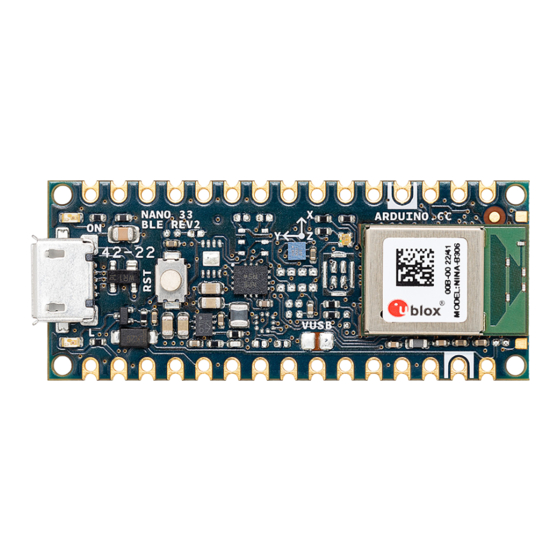
Table of Contents
Advertisement
Quick Links
Description
The Arduino Nano 33 BLE Rev2* is a miniature-sized module containing a NINA B306 module, based on Nordic
nRF52480 and containing an Arm® Cortex®-M4F. The BMI270 and BMM150 jointly provide a 9-axis IMU. The
module can either be mounted as a DIP component (when mounting pin headers) or as a SMT component, directly
soldering it via the castellated pads.
*Nano 33 BLE Rev2 product has two SKUs:
Without headers (ABX00071)
With headers (ABX00072)
Target Areas
Maker, enhancements, IoT application
1 / 14
Arduino® Nano 33 BLE Rev2
Arduino® Nano 33 BLE Rev2
Product Reference Manual
SKU: ABX00071
Modified: 27/02/2024
Advertisement
Table of Contents

Summary of Contents for Arduino Nano 33 BLE Rev2
- Page 1 SKU: ABX00071 Description The Arduino Nano 33 BLE Rev2* is a miniature-sized module containing a NINA B306 module, based on Nordic nRF52480 and containing an Arm® Cortex®-M4F. The BMI270 and BMM150 jointly provide a 9-axis IMU. The module can either be mounted as a DIP component (when mounting pin headers) or as a SMT component, directly soldering it via the castellated pads.
- Page 2 Arduino® Nano 33 BLE Rev2 Features NINA B306 Module Processor 64 MHz Arm® Cortex®-M4F (with FPU) 1 MB Flash + 256 KB RAM Bluetooth® 5 multiprotocol radio 2 Mbps CSA #2 Advertising Extensions Long Range +8 dBm TX power -95 dBm sensitivity 4.8 mA in TX (0 dBm)
-
Page 3: Table Of Contents
2.3 IMU 2.4 Power Tree 2.5 Block Diagram 3 Board Operation 3.1 Getting Started - IDE 3.2 Getting Started - Arduino Web Editor 3.3 Getting Started - Arduino IoT Cloud 3.4 Sample Sketches 3.5 Online Resources 3.6 Board Recovery 4 Connector Pinouts 4.1 USB... -
Page 4: The Board
USB or headers. NOTE: Nano 33 BLE Rev2 only supports 3.3 V I/Os and is NOT 5V tolerant so please make sure you are not directly connecting 5 V signals to this board or it will be damaged. Also, as opposed to other Arduino Nano boards that support 5 V operation, the 5V pin does NOT supply voltage but is rather connected, through a jumper, to the USB power input. -
Page 5: Functional Overview
Arduino® Nano 33 BLE Rev2 2 Functional Overview 2.1 Board Topology Top: Board topology top Ref. Description Ref. Description NINA-B306 Module Bluetooth® Low Energy 5.0 Module MP2322GQH Step Down Converter BMI270 Sensor IMU IT-1185AP1C-160G-GTR Push button BMM150 Magnetometer IC Led L... -
Page 6: Processor
I C peripherals (IMU and Crypto). NOTE: As opposed to other Arduino Nano boards, pins A4 and A5 have an internal pull-up and default to be used as an I C Bus so usage as analog inputs is not recommended. -
Page 7: Block Diagram
Arduino® Nano 33 BLE Rev2 2.5 Block Diagram Block Diagram 7 / 14 Arduino® Nano 33 BLE Rev2 Modified: 27/02/2024... -
Page 8: Board Operation
3.4 Sample Sketches Sample sketches for the Nano 33 BLE Rev2 can be found either in the “Examples” menu in the Arduino IDE or in the “Built-in Examples” section of the Arduino Docs website. -
Page 9: Board Recovery
3.6 Board Recovery All Arduino boards have a built-in bootloader which allows flashing the board via USB. In case a sketch locks up the processor and the board is not reachable anymore via USB it is possible to enter bootloader mode by double- tapping the reset button right after powering up the board. -
Page 10: Usb
Arduino® Nano 33 BLE Rev2 4.1 USB Pin Function Type Description VUSB Power Power Supply Input. If board is powered via VUSB from header this is an Output (1) Differential USB differential data - Differential USB differential data + Analog... -
Page 11: Debug
Arduino® Nano 33 BLE Rev2 Pin Function Type Description D12/MISO Digital SPI MISO; can be used as GPIO 4.3 Debug On the bottom side of the board, under the communication module, debug signals are arranged as 3x2 test pads with 100 mil pitch with pin 4 removed. Pin 1 is depicted in Figure 3 – Connector Positions... -
Page 12: Certifications
6.2 Declaration of Conformity to EU RoHS & REACH 211 01/19/2021 Arduino boards are in compliance with RoHS 2 Directive 2011/65/EU of the European Parliament and RoHS 3 Directive 2015/863/EU of the Council of 4 June 2015 on the restriction of the use of certain hazardous substances in electrical and electronic equipment. -
Page 13: Conflict Minerals Declaration
Arduino® Nano 33 BLE Rev2 6.3 Conflict Minerals Declaration As a global supplier of electronic and electrical components, Arduino is aware of our obligations with regard to laws and regulations regarding Conflict Minerals, specifically the Dodd-Frank Wall Street Reform and Consumer Protection Act, Section 1502. -
Page 14: Company Information
Important: The operating temperature of the EUT can’t exceed 85℃ and shouldn’t be lower than -40℃. Hereby, Arduino S.r.l. declares that this product complies with essential requirements and other relevant provisions of Directive 2014/53/EU. This product is allowed to be used in all EU member states.





Need help?
Do you have a question about the Nano 33 BLE Rev2 and is the answer not in the manual?
Questions and answers